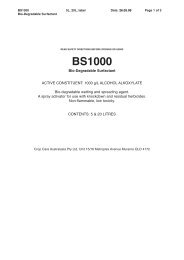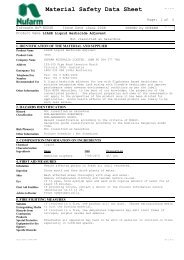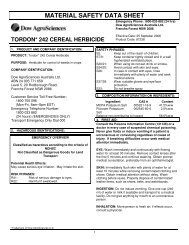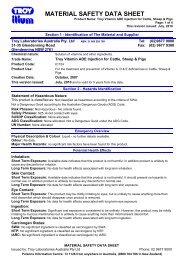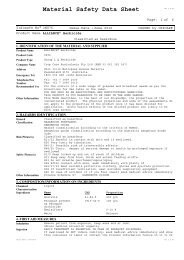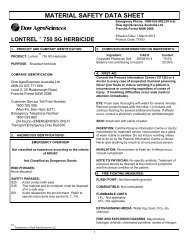Label - Agsure
Label - Agsure
Label - Agsure
- No tags were found...
Create successful ePaper yourself
Turn your PDF publications into a flip-book with our unique Google optimized e-Paper software.
POISONKEEP OUT OF REACH OF CHILDRENREAD SAFETY DIRECTIONS BEFORE OPENING OR USINGVenom® 100 ECINSECTICIDE/MITICIDEACTIVE CONSTITUENT: 100 g/L BIFENTHRINSOLVENT: 748 g/L HYDROCARBON LIQUIDGROUP3AFor the control of Helicoverpa spp. in cotton, tomatoes, lucerne seed crops,navy beans; certain species of mites in bananas, cotton and tomatoes;longtailed mealy bug in pears; banana weevil borer and banana rust thripsin bananas; mirids in cotton; whitefly in tomatoes; and redlegged earthmite, blue oat mite, byrobia mite, webworm and brown pasture looper infaba beans, subterranean clover, clover, canola, wheat, barley, field peas,lupins and lucerne and certain species of wireworms in cotton andsugarcane; fig longicorn in grapes and citrus leafeating weevil in citrus asspecified in the Directions for Use table.www.farmoz.com.auINSECTICIDEDIRECTIONS FOR USE:Restraints: DO NOT use as a foliar spray in banana plantations, or in situations and orchards where mite predators or other beneficialsare established and providing effective mite control and/or other pest control.DO NOT apply as a foliar treatment if rainfall is expected before spray deposits dry on leaf surfaces.DO NOT apply to bananas by aircraft.1. TREE AND VINE CROPSRATEThis table shows rates for dilute spraying. For concentrate spraying,refer to the Mixing/Application section.CROP PEST STATE RATECitrusLeafeating Weevil All States(Eutinophaea bicristata)GrapesFig Longicorn(Acalotepta vastator)NSW,ACT,WA onlyPre-emergence program12.5 or 25 mL/treePost-emergencemonitoring program6 mL/treeCRITICAL COMMENTSFor all uses in this table: Apply by dilute or concentratespraying equipment. Apply the same total amount ofproduct to the target crop whether applying this productby dilute or concentrate spraying methods.Apply as a high volume band application in a 1.5 to 2metres wide swath, to the ground, both sides of the row,under each tree. Aim to apply a total spray volume of 5 to10 L/tree.Pre-emergence program: Apply just prior to, orat the first sign of major beetle emergence inmid-October. Use the higher rate in blocks with a history ofhigh beetle numbers or when longer residual control isrequired.Post-emergence monitoring program: Apply at peak beetleemergence in October/November as indicated by fieldmonitoring. (Refer to monitoring statement on label).Follow-up treatment may be necessary based on athreshold of 25 beetles per 10 sites per orchard inconsecutive counts 1-2 weeks apart.1000 mL/100 L The application MUST be made at late dormancy afterpruning and before bud burst.Apply a single high volume spray, with nozzles directing thespray solution to the trunk and cordons (arms) of grapevines to achieve thorough wetting of the bark.Total spray volume should be about 500 mL/vine achievedby hand application.APVMA Approval No: 56500/0506Venom 100 EC Page 1 of 6
1. TREE AND VINE CROPS - continuedCROP PEST STATE RATE CRITICAL COMMENTSPearsLongtailed Mealybug Vic, 25 mL/100 L plusExamine wood for the presence of over wintering(PseudococcusWA only Ampol DC Tron at 1 L/100 L Longtailed Mealybugs but do not spray until large numberslongispinus)of young nymphs emerge in Spring. Apply this mixture tonear the point of run-off to all above ground parts of thetree between green tip to commencement of flowering.DO NOT spray after flowering has commenced.Peaches,nectarines,plums,apricotsCarpophilus Beetle(Carpophilus spp.)2. OTHER CROPSCROP PEST STATE RATE CRITICAL COMMENTSBananas Banana Weevil Borer Qld,(Cosmopolites sordidus), NSW,Banana Rust Thrips WA,(Chaetanaphothrips NT onlysignipennis)Strawberry Spider Mite(Tetranychus lambi)All States Dilute Spraying50 mL/100 LQld,WA onlyConcentrate SprayingRefer to theMixing/ApplicationsectionSeasonal ProgramStool Treatment Program250-330 mL/100 Ltwice per yearOR660 mL/100 Lonce per yearBand Treatment Program250 mL/100 Ltwice per yearMonitoring ProgramStool Treatment Program330 mL/100 LBand Treatment Program250 mL/100 LMonitor stone fruit orchards for Carphophilus Beetle asfruit approach maturity and become susceptible to attack.Apply VENOM 100 EC as a dilute spray before beetlesreach damaging levels. Apply to the foliage and fruit oftrees.Continue to monitor beetle numbers and if necessaryreapply VENOM 100 EC up to 1 day before harvest or useanother insecticide registered for this purpose.Apply no more than 2 applications per season.There must be a minimum of 10 days between the retreatmentand the initial application.Apply the same total amount of product to the target cropwhether applying this product by dilute or concentratespraying methods.DO NOT use at rates greater than 100 mL per 100 L of waterwhen using concentrate spraying.Cultural control methods (eg. destruction of fallen fruit bymulching) should be used to prevent excessive build up ofCarpophilus Beetle.Seasonal ProgramTwice per year Timing: Apply in October/November (Spring/early Summer) and March/April (lateSummer/Autumn).Use the higher rate (concentration) when borer pressureor damage is high.Once per year TimingApply in October/November OR March/April.Monitoring Program: Monitor Weevil Borer populationscarefully by trap counts and/or corn damage ratings,beginning in September when pest activity is on theincrease and continue until April. Apply treatment whenBanana Weevil Borers reach or exceed acceptablethreshold levels. Monitor borer control after applicationand re-treat as required.Banana Weevil Borer: Application should be made afterrain or irrigation during periods of high adult borer activity.Banana Rust Thrips: Application against banana weevilborer will give coincident rust thrips control particularlywhen application is made when thrips activity is on theincrease usually beginning September and into theSummer months.Application MethodStool Treatment Program: Remove trash from the base ofstools and apply 500-750 mL of spray solution to each stool,depending on stool size. Treat the bottom 30 cm of eachstool as well as the soil in a 30 cm band around each stool,ensuring thorough treatment of both butt(s) and follower(s).Use the lower spray volume of 500 mL on small stools lessthan 50 cm across the entire base.Band Treatment Application: Apply as a band applicationwith a side delivery boom and offset nozzles on both sidesof the row with the spray pattern positioned to spray 30 cmof soil on either side and 30 cm in height. Aim to apply atotal spray volume of 1 L/stool area. For single sucker rowconfigurations apply 28 L of solution per 100 metres of rowin a band 0.5 m wide on each side of the row overlapping inthe centre. For double sucker row configurations apply 56 Lof solution per 100 metres of row in a band 1 m wide oneach side of the double row with the spray patternoverlapping between the rows.40 mL/100 L Monitor mite population and old leaves particularly duringhot dry conditions.Apply VENOM 100 EC as a preventative rather than acurative treatment before damage occurs, and before mitenumbers build up to damaging levels.Follow-up applications may be required at 10-14 dayintervals. Thorough coverage of the lower leaf surface isessential to ensure good control. Use a total spray volumeof 300-500 L/ha.Venom 100 EC Page 2 of 6
2. OTHER CROPS – continuedCROP PEST STATE RATE CRITICAL COMMENTSCottonNative BudwormQld, 600-800 mL/ha Apply as indicated by field checks. Use the higher rate(Helicoverpa punctigera), NSW,when pest pressure is high, conditions favour pestCotton BollwormWA onlydevelopment and when increased residual protection is(Helicoverpa armigera),required.Two Spotted MiteBudworm and Bollworm: Applications should be timed to(Tetranychus urticae),coincide with egg hatch and when small larvae up to 5 mmGreen Miridare present.(Creontiades dilutus),DO NOT apply this product to HelicoverpaApple Dimpling Bug(= Heliothis) armigera larvae larger than 5 mm in length.(Campylomma liebknechti)Two Spotted Mite: Applications against Helicoverpa spp.will give good control of coincident Two Spotted Mite,particularly when applied on low mite populations (around10% leaf infestation). If conditions continue to favour mitedevelopment a second application may be required 14-20days later.Green Mirid & Apple Dimpling Bug: Apply atrecommended threshold levels as indicated by fieldchecks. Use the higher rate for increased pest pressureand longer residual protection.Canola,faba beans,subterraneanclover,clover,barley,field peas,lupins,lucerne,wheatCanolaLucerneseed cropsNavy beansSugarcaneFalse Wireworm(Pterohlaeus alternatus),Sugarcane Wireworm(Agrypnus variabilis)Redlegged Earth Mite(Halotydeus destructor),Brown Pasture Looper(Ciampa arietaria)Blue Oat Mite(Penthaleus major),Pasture Webworm(Hednota spp.)Bryobria Mite(Bryobia spp.)Vegetable Weevil(Listroderes difficils)Native Budworm(Helicoverpa punctigera)Native Budworm(Helicoverpa punctigera),Corn Earworm(Helicoverpa armigera)Sugarcane Wireworm(Agrypnus spp.)375 mL/ha 1OR3.8 mL/100 m of rowAll States 50-100 mL/ha100 mL/ha200 mL/haWireworms: Apply as a spray into the furrow at planting.Use a spray nozzle which will deliver a coarse spray in atotal volume of 60-100 L/ha in a 10 cm band over the seedbefore soil is brought in behind covering tyres in front ofthe press wheel.1The rate is based on a 1 m row spacing.If row spacing varies from 1 m then apply at the use rateaccording to mL/100 m of row.Apply as a broadcast ground rig application in a total watervolume of 50-200 L/ha or by air in a minimum total watervolume of 20 L/ha. Apply to bare soil after conventionalcultivation and sowing or onto well grazed or sprayedpasture after direct drilling. Treat infested paddocks aftersowing.Use the higher rate on heavier infestations and for longerresidual protection.VENOM 100 EC is compatible with some herbicides. Seecompatibility statement for details.All States 100-200 mL/ha Use the 100 mL rate when pest pressure is low. Monitoradjacent habitat and edges of the field for the presence ofVegetable Weevil prior to making a decision whether tospray .All States 400-600 mL/haDO NOT treat lucerne seed crops for alfalfa sproutproduction. Apply as indicated by field checks after thecommencement of flowering. Use the higher rate whenpest pressure is high, conditions favour pest developmentand when increased residual protection is required.Native Budworm: Application should be timed to coincidewith egg hatch and when small larvae up to 5 mm arepresent.All States 600-800 mL/haApply as indicated by field checks after the commencementof flowering. Use the higher rate when pest pressureis high, conditions favour pest development and whenincreased residual protection is required.Budworm and Earworm: Applications should be timed tocoincide with egg hatch and when small larvae up to 5 mmare present.DO NOT apply this product to Helicoverpa(= Heliothis) armigera larvae larger than 5 mm in length.Qld,NSW,WA only375 mL/ha 2OR5.6 mL/100 m of rowApply as a spray into the furrow at planting. Use a spraynozzle which will deliver a coarse spray in a total volume of60-100 L/ha in a band 20-30 cm wide over the base of thefurrow on top of the setts and before covering soil isbrought in by tynes.2The rate is based on a 1.5 m row spacing.If row spacing varies from 1.5 m then apply atthe use rate according to mL/100 m of row.Venom 100 EC Page 3 of 6
2. OTHER CROPS – continuedCROP PEST STATE RATE CRITICAL COMMENTSTomatoesNative Budworm(Helicoverpa punctigera),Corn Earworm(Helicoverpa armigera),Two Spotted Mite(Tetranychus urticue),Tomato Russet Mite(Aculops lycopersici)Whitefly(Trialeurodesvaporariorum)All States High Volume40-60 mL/100 LORLow Volume600 mL/haDO NOT use low volume ground or air application on trellistomatoes.Crop Monitoring ProgramHelicoverpa spp.: Apply as indicated by field checks.Applications should be timed to coincide with egg hatchand when small larvae up to 5 mm are present.DO NOT apply this product to Helicoverpa(= Heliothis) armigera larvae larger than 5 mm in length.Mites: Applications against Helicoverpa spp. will give goodcontrol of coincident mites, particularly when applied onlow mite populations.If conditions continue to favour mite development, asecond application may be required 14-20 days later.Schedule Spray ProgramIf fields are not checked during pest infestation periods,apply on a 7-10 day alternating program with a nonpyrethroidinsecticide. Use the higher rate (high volumeapplication) and shorter interval when pest infestation ismore severe and when increased residual protection isrequired.DO NOT apply this product to Helicoverpa armigera larvaelarger than 5 mm in length.30 mL/100 L water Apply as indicated by pest incident and repeat asnecessary. Use a total spray volume of 2500 L/ha.NOT TO BE USED FOR ANY PURPOSE, OR IN ANY MANNER, CONTRARY TO THIS LABEL UNLESS AUTHORISED UNDERAPPROPRIATE LEGISLATION.WITHHOLDING PERIODS:TOMATOES, PEACHES, NECTARINES, PLUMS, APRICOTS: DO NOT HARVEST FOR 1 DAY AFTER APPLICATION.BANANAS:FOR GROUND APPLICATION – DO NOT HARVEST FOR 1 DAY AFTER APPLICATION.FOR FOLIAR APPLICATION – DO NOT HARVEST FOR 8 DAYS AFTER APPLICATION.COTTON:DO NOT HARVEST FOR 14 DAYS AFTER APPLICATION.DO NOT GRAZE OR CUT FOR STOCKFEED.DO NOT FEED COTTON TRASH TO LIVESTOCK.DO NOT GRAZE OR CUT FOR STOCK FEED. DO NOT FEED COTTON TRASH TO LIVESTOCK.PEARS:DO NOT HARVEST FOR 14 DAYS AFTER APPLICATION.NAVY BEANS:DO NOT HARVEST, GRAZE OR CUT FOR STOCK FOOD FOR 14 DAYS AFTER APPLICATION.CANOLA, SUBTERRANEAN CLOVER, CLOVER, FIELD PEAS, FABA BEANS, WHEAT, BARLEY, LUCERNE, LUPINS:DO NOT GRAZE OR CUT FOR STOCK FOOD FOR 4 WEEKS AFTER APPLICATION.HARVEST WHP NOT REQUIRED WHEN USED AS DIRECTED.CITRUS, GRAPES, SUGARCANE: NOT REQUIRED WHEN USED AS DIRECTED.Venom 100 EC Page 4 of 6
GENERAL INSTRUCTIONSFARMOZ VENOM 100 EC Insecticide/Miticide is a contact and residualinsecticide/miticide. It can be used as a protective treatment whenapplied at regular intervals or as a knockdown treatment to controlexisting pests.Best results are obtained when VENOM 100 EC is applied before pestpopulations build up to damaging levels.This product is not suitable for use in Integrated Pest Management(IPM) programme where mite predators are established and providingeffective mite control.APPLICATIONVENOM 100 EC may be applied by either ground or aircraft. Thoroughcoverage is essential to ensure adequate control.DO NOT apply as a fog or mist.1. Tree and Vine CropsDilute SprayingUse a sprayer designed to apply high volumes of water up to the pointof run-off and matched to the crop being sprayed. Set up and operatethe sprayer to achieve even coverage throughout the crop canopy.Apply sufficient water to cover the crop to the point of run-off. Avoidexcessive run-off. The required water volume may be determined byapplying different test volumes, using different settings on the sprayer,from industry guidelines or expert advice. Add the amount of productspecified in the Directions For Use table for each 100 L of water. Sprayto the point of run-off. The required dilute spray volume will changeand the sprayer set up and operation may also need to be changed, asthe crop grows.Concentrate SprayingUse a sprayer designed and set up for the concentrate spraying (thatis a sprayer which applies water volumes less than those required toreach the point of run-off) and matched to the crop being sprayed. Setup and operate the sprayer to achieve even coverage throughout thecrop canopy using your chosen water volume. Determine anappropriate dilute spray volume (See Dilute Spraying above) for thecrop canopy. This is needed to calculate the concentrate mixing rate.The mixing rate for concentrate spraying can then be calculated in thefollowing way:EXAMPLE ONLY1. Dilute spray volume as determined above: For example 1500 L/ha.2. Your chosen concentrate spray volume: For example 500 L/ha.3. The concentration factor in this example is: 3x (ie 1500 L ÷ 500 L = 3).4. If the dilute label rate is 10 mL/100 L, then the concentrate ratebecomes 3 x10, that is 30 mL/100 L of concentrate spraying.The chosen spray volume, amount of product per 100 L of water, andthe sprayer set up and operation may need to be changed as the cropgrows.For further information on concentrate spraying, users are advised toconsult relevant industry guidelines, undertake appropriatecompetency training and follow industry Best Practices.2. Other CropsGround Application: Applications should be made as a fine spraypreferably using hollow cone nozzles and a droplet size of 150 to 200microns. The application volume will depend on the type of crop to betreated. The following are suggested:Low volume broadacre applications to – e.g. cereals, canola, grainlegumes, lucerne, subterranean clover: 50-200 L/ha.Low volume row crops applications to cotton, tomatoes, navy beans:50-200 L/ha.High volume applications to row crops – e.g. trellised tomatoes:200-1000 L/ha except as noted in critical comments. Use 200 L/ha fromtransplanting increasing to 1000 L/ha at maturity.Grapes: Apply by hand application, using a high volume coarse sprayof 500mL/vine. (e.g. at approx. 2500 vines/ha = 1250L/ha)High volume application to stone fruit: 1000 to 2000 L/ha.Foliar sprays to bananas: 300 to 500 L/haSOIL APPLIED SPRAYSHigh Volume ApplicationBananas:Stool treatment: Apply as a coarse spray at 500-750 mL per stool.Band treatment: Apply as a band application with a side delivery boomand offset nozzles – 1 L of spray solution per stool.Citrus: Apply as a high volume, directed spray to the ground undereach tree. For optimum control apply to both sides of the tree. Totalspray volume should be 5 to 10 L/tree (e.g. at 250 trees/ha = 1250 to2500L/ha).IN FURROW APPLICATIONSCotton & Sugarcane: Use a coarse spray: 60 to 100 L/ha as a band overthe seed or sett before covering with soil – refer to critical commentsfor details.AERIAL APPLICATIONSUse at least 20 L/ha of total spray volume. Spray during the coolerparts of the day or night. To reduce possibility of drift avoid spraying incalm conditions or when wind is light and variable. Preferably, spray ina crosswind. Use suitable application equipment and/or nozzles todeliver a fine spray with a droplet size of 150 to 200 microns.A spraydrift minimisation strategy should be employed at all timeswhen aerially applying sprays to, or near, sensitive areas. The strategyenvisaged is best exemplified by the cotton industry’s BestManagement Practice manual.MONITORINGPost-emergence monitoring of Citrus Leafeating Weevil populations:At first sign of major beetle emergence in mid-October commencemonitoring at 1 to 2 week intervals.Place polystyrene fruit box (330 x 480 mm) under tree, shake branchesvigorously, repeat on ten randomly selected trees throughout orchid.If 25 beetles or more are recorded in consecutive counts, treatment isrequired.MIXINGAdd the required quantity of VENOM 100 EC to water in the spray tankand mix thoroughly. Maintain agitation during mixing and application.COMPATIBILITYVENOM 100 EC is compatible with commonly used fungicides such asAntracol † , Fung-o-nil ® , and the herbicides Sprayseed † , Broadstrike † ,Spinnaker † , FARMOZ Simazine 500, Clincher ® , FARMOZ Metribuzin,Wipe-Out ® , Lonestar ® and Stomp † .SURFACTANTSAdditional surfactant may only be necessary on hard to wet plants andin high volume situations. Wetspay 1000 is recommended at labelrates.NOTICE: Helicoverpa (= Heliothis) armigera resistance in NorthernNSW and Qld. To help contain pyrethroid resistance in H. armigera, theSummer Crop Insecticide strategy as developed by the Qld Departmentof Primary Industries and NSW Agriculture should be adhered to.Failure to observe the strategy may result in widespread resistanceaffecting the future viability of summer cropping.INSECTICIDE RESISTANCE WARNINGFARMOZ VENOM ® 100 EC Insecticide/ GROUPMiticide is a Group 3A insecticide.3A INSECTICIDESome naturally occurring insect biotypes resistant to VENOM 100 ECand other Group 3A insecticides may exist through normal geneticvariability in any insect population. The resistant individuals caneventually dominate the insect population if VENOM 100 EC or otherGroup 3A insecticides are used repeatedly. The effectiveness ofVENOM 100 EC on resistant individuals could be significantly reduced.Since the occurrence of resistant insects is difficult to detect prior touse, FARMOZ Pty. Ltd. accepts no liability for any losses that mayresult from the failure of VENOM 100 EC to control resistant insects.VENOM 100 EC may be subject to specific resistance managementstrategies. For further information contact your local supplier, FARMOZrepresentative or local agricultural department agronomist.STONE FRUIT EXPORT ADVICEExport of Treated Stone Fruit – Some export markets do not havesuitable Maximum Residue Limits or import tolerances in place. Pleasecontact FARMOZ Pty. Ltd. or the Australian Fresh Stone Fruit GrowersAssociation prior to using this product on crops destined for export.RE-ENTRY TO TREATED FIELDS/CROPSDO NOT re-enter treated field/crop until spray deposits have dried,unless wearing suitable protective clothing (ie. waterproof hat,overalls, boots and gloves).PROTECTION OF WILDLIFE, FISH, CRUSTACEANS ANDENVIRONMENTDangerous to fish and aquatic organisms. DO NOT contaminate dams,rivers, streams, waterways or drains with this product or the usedcontainer. Tail drains which flow from treated areas should beprevented from entering river systems.PROTECTION OF LIVESTOCKDangerous to bees. DO NOT spray any plants in flower when bees areforaging. Spray in the early morning when bees are not activelyforaging.STORAGE AND DISPOSAL (1 L)Store in the closed, original container in a cool, well ventilated area.DO NOT store for prolonged periods in direct sunlight. Triple orpreferably pressure rinse containers before disposal. Add rinsings tospray tank. DO NOT dispose of undiluted chemicals on site. Ifrecycling, replace cap and return clean containers to recycler ordesignated collection point. If not recycling, break, crush or punctureand bury empty containers in a local authority landfill. If no landfill isVenom 100 EC Page 5 of 6
available, bury the containers below 500 mm in a disposal pitspecifically marked and set up for this purpose clear of waterways,desirable vegetation and tree roots. Empty containers and productshould not be burnt.STORAGE AND DISPOSAL (5 L, 10 L, 20 L, 200 L)Store in the closed, original container in a well-ventilated area as coolas possible, out of direct sunlight. This container can be recycled if it isclean, dry, free of visible residues and has the drumMUSTER logovisible. Triple or pressure rinse container for disposal. Add rinsings tospray tank. Dispose of the rinsate by adding it to the spray tank. DONOT dispose of undiluted chemicals on site. Wash outside of thecontainer and the cap. Store cleaned container in a sheltered placewith cap removed. It will then be acceptable for recycling at anydrumMUSTER collection or similar container management programsite. The cap should not be replaced but may be taken separately. Ifnot recycling, break, crush or puncture and bury empty containers in alocal authority landfill. If no landfill is available, bury the containerbelow 500 mm in a disposal pit specifically marked and set up for thispurpose, clear of waterways, desirable vegetation and tree roots.Empty containers and product should not be burnt.For refillable containers, empty contents fully into applicationequipment. Close all valves and return to point of supply for refill orstorage.Envirodrum Micro Matic Valve (60 L, 110 L)Store the original sealed Envirodrum in a cool well-ventilated area. DONOT store for prolonged periods in direct sunlight. DO NOT tamperwith the Micro Matic valve or the security seal. DO NOT contaminatethe Envirodrum with water or any foreign matter. After each use of theproduct, please ensure that the Micro Matic coupler delivery systemand hoses are disconnected, triple rinsed with clean water anddrained accordingly. When the contents of the Envirodrum have beenused, please return the Envirodrum to the point of purchase. TheEnvirodrum remains the property of FARMOZ Pty. Ltd.1000 LStore in the closed, original container in a cool, well-ventilated areas.DO NOT store for prolonged periods in direct sunlight. Storage must besecure so that contents cannot be tampered with. All locks and/orseals must be in order. If locks or seals are broken prior to initial usethen the integrity of this product cannot be assured. If this occursFARMOZ Pty. Ltd. should be advised immediately. This minibulkcontainer is reusable and remains the property of FARMOZ Pty. Ltd. DONOT rinse empty container. Empty contents fully into applicationequipment. Close all valves and return to the point of supply for refill orstorage. No other liquid, solid or pesticide product should be put into it.When empty return to FARMOZ Pty. Ltd. for cleaning, relabelling andrefilling.SAFETY DIRECTIONSPoisonous if swallowed. Attacks eyes. Will irritate the skin. Avoidcontact with eyes and skin. If product in eyes, wash it out immediatelywith water. DO NOT inhale spray mist. When preparing spray, wearcotton overalls buttoned to the neck and wrist and washable hat,elbow-length PVC gloves and goggles. When using the prepared spraywith hand held application equipment in bananas and grapes wearcotton overalls buttoned to the neck and wrist and elbow-length PVCgloves. Wash hands after use. After each day’s use, wash gloves,goggles and contaminated clothing.FIRST AIDIf poisoning occurs, contact a doctor or Poisons Information Centre.Phone Australia 131126. If swallowed, do NOT induce vomiting. Give aglass of water.MSDSAdditional information is listed in the material safety data sheet(MSDS). A material safety data sheet for VENOM 100 EC is availablefrom FARMOZ on request. Call Customer Service on (02) 9431 7800.CONDITIONS OF SALE: The use of FARMOZ VENOM 100 EC Insecticide/Miticide beingbeyond the control of the manufacturer, no warranty expressed or implied is given byFARMOZ Pty. Ltd., regarding its suitability, fitness or efficiency for any purpose forwhich it is used by the buyer, whether in accordance with the directions or not andFARMOZ Pty. Ltd. accepts no responsibility for any consequence whatsoever resultingfrom the use of this product.®Registered trademarks of FARMOZ Pty. Ltd.† Other trademarksUN 3082ENVIRONMENTALLY HAZARDOUS SUBSTANCE,LIQUID, N.O.S.(CONTAINS BIFENTHRIN)PACKAGING GROUP IIIHAZCHEM 2XMISCELLANEOUSDANGEROUSGOODS9PACK SIZES: 1 L, 5 L, 20 L, 200 L, 60 L, 110 L, 200 L, 1000 LVenom 100 EC Page 6 of 6



